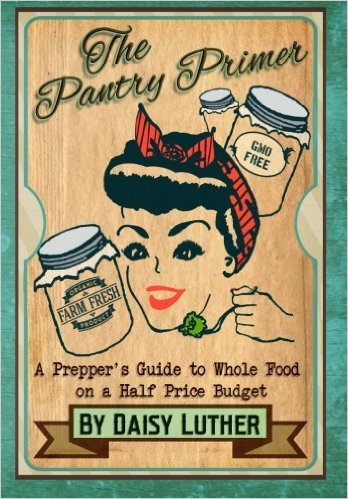If you're new here, you may want to subscribe to my RSS feed. Thanks for visiting!
All it takes is reading the headlines for a few days with the slightest sense of awareness to realize that this country is in trouble. With crises ranging from our crumbling economy, an encroaching police state, the devolution of civilization, possible grid-down scenarios and cyber attacks, and the risk of natural disasters, a one year preparedness pantry is no longer just something that Mormons and those crazy preppers do. It is a logical answer to the threats that we face every day, and as prices escalate, the time to get it together is NOW.
Putting a rush on preparedness can be overwhelming, but when you thoroughly understand the process, you can streamline the acquisition of your one year pantry. Over the past 3 months, I’ve rebuilt my one year pantry from the ground up and documented it in my series, The Pantry Primer. This is a quick review and summary of the steps I took.
1.) Getting Started
Every journey starts with a single step, as they say, so I began by making a list and going on a shopping trip. I purchased enough basics to get us through a week, and made a few purchases that would increase my ability to cook from scratch (like flour, dried beans, baking powder, and peanut butter). Because I started out with no pantry basics, I had to get a few things I wouldn’t normally purchase, like boxed cereal, some canned organic soups, and ready made crackers.
2.) Meal Planning
While building a stockpile, meal planning takes on a different focus. You have to break down your shopping into two categories: the stuff you need for the week and the additions to your stockpile. So, that bag of rice might serve both purposes, but the green pepper you’re getting will only serve one. Also remember that the meals you make right now can add to your stockpile. Take, for example, a roasted whole chicken. After you enjoy a couple of meals from that, you can take the remaining meat and bones and make a homemade stock, then can that stock to add to your pantry. The same holds true for a huge pot of chili or soup. Be sure to stick to your budget! I use the envelope method to keep myself on track.
3,) Stretch Your Budget with Home Preservation
Lots of times you can find better deals on items that are fresh, but marked down. I often purchase meat and produce this way. By using simple home preservation methods like canning and dehydration, you can add these high quality additions to your stockpile at a much lower price. Combine the bargains into soups and stews and pressure can them. Dehydrate vegetables and fruits to reconstitute for a boost of vitamins and minerals in your freshly made casseroles.
4.) Adding Larger Purchases to your Stockpile
Weekly grocery shopping is not the best way to build your stockpile. Once you’ve established a base of groceries, you can eat from this small stockpile for a few weeks to save enough money to make some larger purchases. Not only do larger purchases add more quickly to your supplies, but generally speaking, they save a great deal of money from those smaller packages that come from the grocery store shelves.
5.) Building the Ultimate Pantry
People create food storage stockpiles for many different reasons, and because of this, there is no “one-size-fits-all” formula for doing so. You must figure out what your goals are and develop a road map towards achieving them. There are three basic types of food supplies: the Bunker Pantry, the Agrarian Pantry, and the Bargain Hunter’s Pantry. Learn about these food storage ideologies and then take the most applicable strategies and combine them to create your own version of the Ultimate Pantry.
6.) Building Your Protein Stockpile
Because meat is so perishable (and also expensive) protein is often the most neglected frontier of the one-year pantry. Particularly in a disaster situation, you may be called upon to perform much harder physical labor than you are accustomed to. It is a necessity to provide your body with the building blocks it needs to repair itself and become stronger. Consider vegetarian sources of protein, buy in quantity, and learn to preserve meat to build up your protein stockpile.
7.) Stocking Your Supply of Fruits and Vegetables
A major challenge when living from your stockpiled foods is getting enough fruits and vegetables. Without produce, your family can be at risk for nutritional deficiency diseases like scurvy and their immune systems will be compromised. A minimum of 5 servings per day is recommended. Supplying your family with produce that will provide the necessary nutrients that their bodies need to thrive is a twofold process. Not only should you preserve the summer’s bounty for the winter ahead, but you should also come up with ways to add fresh greens outside of the growing season.
8.) Stockpiling the Basics for Scratch Cooking
To be efficient, every pantry requires certain basics that allow for scratch cooking. A good pantry should have everything you need to whip together a pie, a loaf of bread, or a batch of biscuits with no trip to the store required. Many of these basics, like baking items, sweeteners, fats, and other miscellaneous staples, can be purchased in large quantities.
9.) Stockpiling Grains
Food storage calculators recommend 300 pounds of grains per person for a one year supply. For a family of four, that is a whopping 1200 pounds of grains that you should store if you are trying to build a one year pantry! That sounds like a really daunting number until you remember that it is divided over many different items. Most grains can be purchased in very large quantities at a greatly reduced price.
10.) Where to Stash Your Stockpile
A very common question for preppers is, “Where on earth do you store all of that food?” Unless you have a pantry the size of a master bedroom suite, it won’t take long to exceed the limits of your available kitchen storage. But don’t despair! There are lots of little nooks, crannies, and storage areas around most homes that will allow you to discreetly put away a year’s supply of food for your family. It’s equally important to devise a system to help you find the items that you’ve stashed away.
11.) Maintaining Your Stockpile
Now that your stockpile is built, you must maintain it. You don’t want to end up back at square one a year from now. You must rotate items into use in your kitchen, store them for the longest possible lifespan, and replenish them at the best prices available, which will entail tracking of sales cycles, couponing, and bulk purchasing. A careful inventory should also be maintained, so that you don’t drop too low in any one item.
Conclusion
If you’ve followed these steps you should be well on your way to acquiring a one year supply of food by now. This is your key to maintaining your independence in the midst of a crisis, whether it is economic, natural, or man-made. Whatever happens, you can feel confident that you will be able to nourish your family without waiting for a handout.
You can easily apply these principles to acquiring other preparedness items that you need. You’ll save money, prepare for crisis, and ensure your family’s independence.
Those of us who prepare for the difficult times ahead are the ones who stand between the total domination of the powers that be and the freedom that they would take away from us. By understanding how hunger can be used against us, and then taking the initiative to prepare for that grim day, we can’t be controlled as easily as those who have spent years accepting the handouts and trudging along with the herd.
By making intelligent choices to ensure our survival and that of our children, we can resist. Every meal that you put away keeps you a little bit safer from tyranny. Every seed you plant hardens you against threats and bribery. Your self-sufficiency is what will keep you free.
Want to learn more? My new book is now available!
Lots of us like to have hard copies of information that we’ve found helpful. Because of this, I’ve expanded on the information included in this series and put it all in one handy primer, available on Amazon.


















I can’t begin to tell you how much I appreciate this series, Daisy!
Thank you for compiling it!
This is beyond amazing information. Thank you sooooo much!
Something I would personally recommend for stocking up protein is purchasing protein powders in 2 or 5lb containers. You save money when buying them in that size vs. a pound or less and on top of they, they stay great forever!